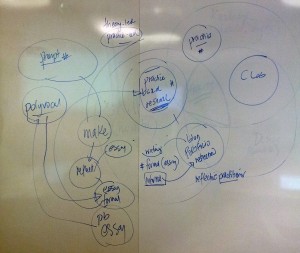Glass of Juice from Troy on Vimeo.
This was the final sketch that I created which was an instructional video on how to pour a glass of juice. This was a satire once again of The Katering Show on their cooking segments. I wanted it to be an extremely simple task that almost anyone could do to highlight how cooking shows tend to talk down to the viewer. The humour was not necessarily from the acting or dialogue but rather the nonsensical thought that the viewer did not have the ability to open up a fridge and pour themselves a glass of juice. To add to the confusion I say I am pouring orange juice when in fact I am using apple to fill the glass.
For this video I tried to incorporate all of the previous feedback from the other videos as well as what I felt worked well. I used the tripod for most of the shots with close-up of each of the actions performed. I also tried to break-up the dialogue by using multiple camera angles when speaking to the camera. I also used the DSLR to film the video which from previous videos yielded the best results as well as the natural lighting which seems to create the best atmosphere for the video. If I was to do this video again I would have added some music to complete the intended effect otherwise I’m happy with the outcome of this video.
